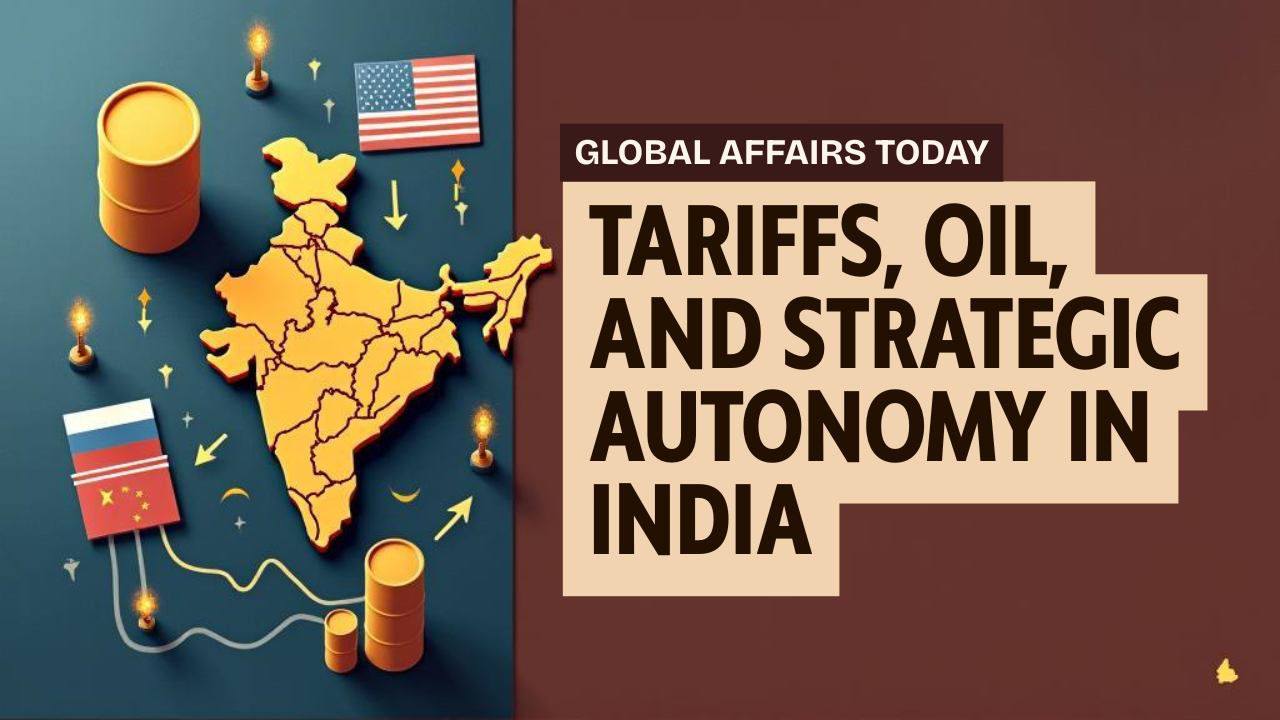
Tariffs, Oil, and Strategic Autonomy: India’s Delicate Balancing Act Between the U.S., Russia, and China
By Ishani Aprajita
In a world where geopolitics is as much about economics as it is about diplomacy, India is finding itself walking a tightrope between major powers. Recent developments involving the United States, Russia, and China have highlighted the complexity of this balancing act. With U.S.-India trade talks facing turbulence, oil imports from Russia becoming a flashpoint, and China extending a warm welcome to India for the upcoming Shanghai Cooperation Organisation (SCO) summit, the contours of India’s foreign policy are being tested like never before.
The Tariff Trigger
Tensions flared after the United States, under President Donald Trump, imposed a 50% tariff on Indian goods as a retaliatory measure for India’s continued imports of Russian crude oil. This was in addition to an earlier 25% tariff on Indian exports. The message from Washington was clear: reduce energy ties with Moscow or face economic consequences.
Trade negotiations under the Bilateral Trade Agreement (BTA), which had seen multiple rounds of discussions, now face an uncertain future. While both sides have made progress in expanding defence cooperation, the tariff issue risks overshadowing these gains.
India’s Oil Imperative
External Affairs Minister S. Jaishankar was quick to draw a line in the sand. Comparing India’s situation to past U.S. actions against Iran, he argued that Russia is not Iran—and India cannot simply switch off its largest oil supplier overnight. With over 33% of India’s crude imports coming from Russia, the dependence is not just economic but also strategic.
Russia offers favourable pricing, long-term supply security, and remains a critical defence partner. Any abrupt disruption would ripple through India’s economy, raising energy costs, increasing inflation, and straining fiscal resources.
Adding to the irony, China—importing even more Russian oil than India—has faced no similar punitive measures, raising questions about consistency in U.S. sanctions policy.
Defence Cooperation in the Shadow of Tariffs
The strain is already visible. Defence Minister Rajnath Singh has postponed his U.S. visit, which was intended to finalise co-production agreements for advanced defence systems like Stryker armoured vehicles, anti-tank missiles, and UAVs.
The visit was also expected to expand the India–U.S. Defence Acceleration Ecosystem (INDUS-X) framework. While officials insist the delay is temporary, the optics suggest that trade disputes could spill over into the strategic sphere.
China and the SCO Connection
Even as ties with Washington experience strain, Beijing has extended an olive branch. China welcomed Prime Minister Narendra Modi’s planned visit to Tianjin for the SCO summit, framing it as a “gathering of solidarity, friendship, and fruitful results.”
India’s participation in the SCO—dominated by China and Russia—sends a subtle message: New Delhi is committed to multi-alignment rather than choosing sides. This is a classic case of strategic autonomy in action—engaging with all major powers while preserving sovereign decision-making.
Domestic Economic Cushion
Amid the global energy and trade turbulence, the Union Cabinet has approved a ₹30,000 crore compensation to public sector oil companies for supplying subsidised LPG under the Pradhan Mantri Ujjwala Yojana (PMUY). The subsidy, at ₹300 per 14.2 kg cylinder for up to nine refills a year, is aimed at shielding vulnerable households from the brunt of rising global fuel prices.
Why This Matters for India’s Strategic Future
The interplay between tariffs, energy security, and defence cooperation underscores a fundamental truth: India’s rise as a global power depends on its ability to navigate competing demands without compromising its core interests.The U.S. remains a critical technology and defence partner, but its sanctions policy can conflict with India’s energy imperatives.Russia is indispensable for both energy and defence, even as it draws global criticism over Ukraine.China, despite tensions, remains a major economic partner and a player in multilateral forums India cannot ignore.
In this web of interdependence, India’s strategic autonomy is not just a principle—it is a necessity India’s current geopolitical challenge is like playing chess on three boards simultaneously—trade with the U.S., energy with Russia, and diplomacy with China. Every move has implications for the other two games. As global power dynamics shift, India’s ability to maintain this balancing act will determine not only its economic resilience but also its stature as a major power in the evolving world order.
.





